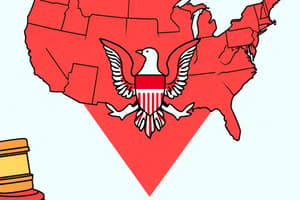Podcast
Questions and Answers
In which type of federal system do national and subnational institutions cooperate and share power more?
In which type of federal system do national and subnational institutions cooperate and share power more?
- Confederation
- Competitive federal system
- Cooperative federal system (correct)
- Unitary system
Under which system does the central government have the power to act and make laws while subnational governments are subordinate?
Under which system does the central government have the power to act and make laws while subnational governments are subordinate?
- Unitary system (correct)
- Confederation
- Cooperative federal system
- Competitive federal system
What principle divides the American government among legislative, executive, and judicial institutions?
What principle divides the American government among legislative, executive, and judicial institutions?
- Principle of confederation
- Principle of sovereignty
- Principle of federalism
- Principle of separation of powers (correct)
Which constitution gave states sovereignty and power while the national government was subordinate and weak?
Which constitution gave states sovereignty and power while the national government was subordinate and weak?
What are the distinct institutions in a competitive federal system?
What are the distinct institutions in a competitive federal system?
What is the main focus of power sharing as described in the text?
What is the main focus of power sharing as described in the text?
In a federal system, what does the central government's ability to act depend on?
In a federal system, what does the central government's ability to act depend on?
What is the role of federalism in power sharing, based on the text?
What is the role of federalism in power sharing, based on the text?
What does decentralization involve, according to the text?
What does decentralization involve, according to the text?
What is an essential characteristic of power sharing in a federal system?
What is an essential characteristic of power sharing in a federal system?
Flashcards are hidden until you start studying
Study Notes
Power sharing is a constitutional mechanism that divides power between different levels of government, such as the national and subnational levels, to guarantee autonomy and autonomy over certain policy areas while sharing power in accordance with agreed rules over other areas This article will delineate the subtopics of federalism, decentralization, and separation of powers, focusing on their role in power sharing.
-
Federalism: Federalism is a constitutional mechanism that divides power between different levels of government, such as the national and subnational levels, to guarantee autonomy and autonomy over certain policy areas while sharing power in accordance with agreed rules over other areas In a federal system, the central government's ability to act depends on the consent of the subnational governments The United States, for
-
Decentralization:
-
Separation of Powers:
In the United States, the Constitution safeguards the rights of the states by reserving all powers not delegated to the federal government to the states The separation of powers principle has different effects on the American Federal Government System Firstly, the principle divides the government among several institutions - legislative, executive, and judicial - and each of them has its own distinct power in decision- making This division of powers and functions between the national government and the state governments is a key principle of federalism
In competitive federal systems, national and subnational institutions regard themselves as fundamentally distinct institutions, overlapping in territorial jurisdictional boundaries In cooperative federal systems, national and subnational institutions cooperate and share power more will
In a confederation, authority is decentralized, and the central government's ability to act depends on the consent of the subnational governments Under the Articles of Confederation (the first constitution of the United States), states were sovereign and powerful while the national government was subordinate and weak The Constitution contains several provisions that direct the functioning of U.S. federalism, such as the enumerated powers of the national legislature, which define the jurisdictional boundaries within which the federal government has authority
In a unitary system, the central government has the power to act and make laws, while subnational governments have limited authority and are subordinate to the central government In a federal system, the central government's ability to act depends on the consent of the subnational governments
In a confederation, authority is decentralized, and the central government's ability to act depends on the consent of the subnational governments Under the Articles of Confederation (the first constitution of the United States), states were sovereign and powerful while the national government was subordinate and weak The Constitution contains several provisions that direct the functioning of U.S. federalism, such as the enumerated powers of the national legislature, which define the jurisdictional boundaries within which the federal government has authority
In a unitary system, the central government has the power to act and make laws, while subnational governments have limited authority and are subordinate to the central government In a federal system, the central government's ability to act depends on the consent of the subnational governments
In a confederation, authority is decentralized, and the central government's ability to act depends on the consent of the subnational governments Under the Articles of Confederation (the first constitution of the United States), states were sovereign and powerful while the national government was subordinate and weak The Constitution contains several provisions that direct the functioning of U.S. federalism, such as the enumerated powers of the national legislature, which define the jurisdictional boundaries within which the federal government has authority
In a unitary system, the central government has the power to act and make laws, while subnational governments have limited authority and are subordinate to the central government In a federal system, the central government's ability to act depends on the consent of the subnational governments
In a confederation, authority is decentralized, and the central government's ability to act depends on the consent of the subnational governments Under the Articles of Confederation (the first constitution of the United States), states were sovereign and powerful while the national government was subordinate and weak The Constitution contains several provisions that direct the functioning of U.S. federalism, such as the enumerated powers of the national legislature, which define the jurisdictional boundaries within which the federal government has authority
In a unitary system, the central government has the power to act and make laws, while subnational governments have limited authority and are subordinate to the central government In a federal system, the central government's ability to act depends on the consent of the subnational governments
In a confederation, authority is decentralized, and the central government's ability to act depends on the consent of the subnational governments Under the Articles of Confederation (the first constitution of the United States), states were sovereign and powerful while the national government was subordinate and weak The Constitution contains several provisions that direct the functioning of U.S. federalism, such as the enumerated powers of the national legislature, which define the jurisdictional boundaries within which the federal government has authority
In a unitary system, the central government has the power to act and make laws, while subnational governments have limited authority and are subordinate to the central government In a federal system, the central government's ability to act depends on the consent of the subnational governments
In a confederation, authority is decentralized, and the central government's ability to act depends on the consent of the subnational governments Under the Articles of Confederation (the first constitution of the United States), states were sovereign and powerful while the national government was subordinate and weak The Constitution contains several provisions that direct the functioning of U.S. federalism, such as the enumerated powers of the national legislature, which define the jurisdictional boundaries within which the federal government has authority
In a unitary system, the central government has the power to act and make laws, while subnational governments have limited authority and are subordinate to the central government In a federal system, the central government's ability to act depends on the consent of the subnational governments
In a confederation, authority is decentralized, and the central government's ability to act depends on the consent of the subnational governments Under the Articles of Confederation (the first constitution of the United States), states were sovereign and powerful while the national government was subordinate and weak The Constitution contains several provisions that direct the functioning of U.S. federalism, such as the enumerated powers of the national legislature, which define the jurisdictional boundaries within which the federal government has authority
In a unitary system, the central government has the power to act and make laws, while subnational governments have limited authority and are subordinate to the central government In a federal system, the central government's ability to act depends on the consent of the subnational governments
In a confederation, authority is decentralized, and the central government's ability to act depends on the consent of the subnational governments Under the Articles of Confederation (the first constitution of the United States), states were sovereign and powerful while the national government was subordinate and weak The Constitution contains several provisions that direct the functioning of U.S. federalism, such as the enumerated powers of the national legislature, which define the jurisdictional boundaries within which the federal government has authority
In a unitary system, the central government has the power to act and make laws, while subnational governments have limited authority and are subordinate to the central government In a federal system, the central government's ability to act depends on the consent of the subnational governments
In a confederation, authority is decentralized, and the central government's ability to act depends on the consent of the subnational governments Under the Articles of Confederation (the first constitution of the United States), states were sovere
Studying That Suits You
Use AI to generate personalized quizzes and flashcards to suit your learning preferences.




